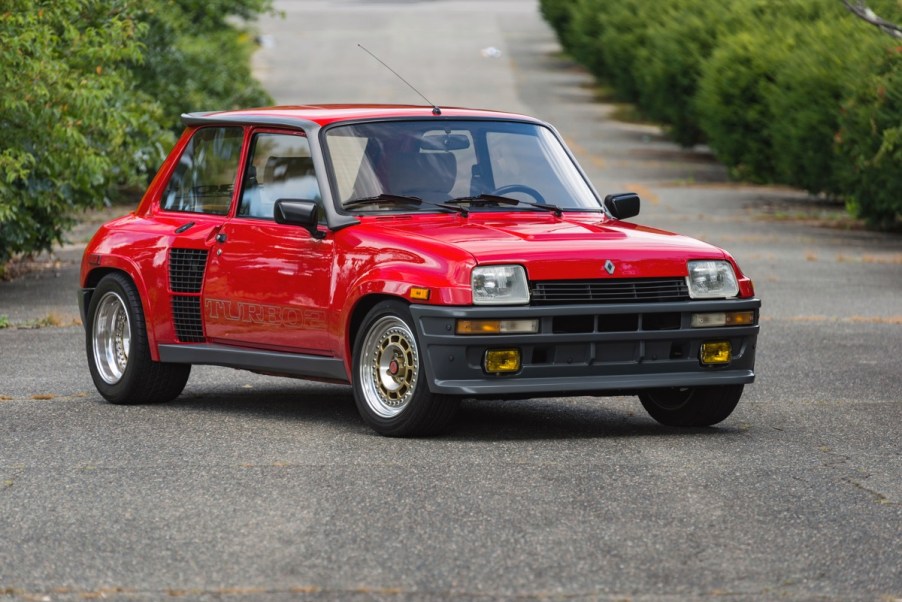
Renault 5 Turbo: Mid-Engine, RWD, Rally Racer…Hatchback
Racing homologation specials are often significantly different than the cars they’re based on. Mitsubishi’s Lancer Evolution got a larger engine and all-wheel drive. The Toyota Celica GT4 got that, plus a factory water-injection system. The Mitsubishi Pajero Evolution, meanwhile, got a revised suspension, reinforced frame, limited-slip differentials, and Recaro seats. The Isuzu Vehicross, though, looked that way from the start. But when it comes to differences between base and homologation, few can top the Renault 5 Turbo.
The Renault 5 Turbo’s engine was the least unusual change

As Petrolicious explains, in the early 70s Lancia was dominating rallying with the Stratos. This was one of the first purpose-built rally cars, and its mid-engine design gave it agile handling. Renault had seen some success with the similar Alpine A110, but it simply couldn’t keep up with the Stratos.
Renault didn’t have the budget to create a brand-new race car. So, as with the BMW M Coupe, the company’s engineers attempted to save costs by creating a racing version of the popular Renault 5 supermini. The first version, the Renault 5 Alpine, was more powerful than the standard car (93 hp vs 55 hp) and had some success in rallies. But the French company wanted to go even further. And in 1980, the Renault 5 Turbo debuted—and it was quite a departure from the base car.

Firstly, as Evo explains, the base Renault 5 was a front-engine, front-wheel-drive car. The Renault 5 Turbo, on the other hand, was mid-engine with rear-wheel drive. That’s right: instead of rear seats, the Renault 5 Turbo had a turbocharged 1.4-liter four-cylinder and a 5-speed transmission. Simply mounting the engine there required fitting an additional tubular frame around it. But the modifications go further.

To make room for the engine, the Renault 5 Turbo’s rear track was 10” wider than the standard car’s. Even so, to save space, the rear suspension had to be upgraded to a more-compact double-wishbone and coilover setup. That also had the added benefit of improving the car’s handling. The Renault 5 Turbo’s engine was further modified, replacing the carburetors with fuel injectors, and with an air-to-air intercooler mounted in its iconic fender flares.
What was the Renault 5 Turbo like to drive?
When it came out in 1980, the Renault 5 Turbo put out 160 hp and 163 lb-ft, The Drive reports. That made it, Top Gear reports, the most powerful French car ever made up until then. Racing versions pushed out close to 250 hp, with the later Maxi Turbo putting out about 350 hp, Petrolicious reports.
With the car’s short wheelbase, lifting off the throttle can provoke a drift, as in vintage Porsche 911s, Petrolicious explains. But if you stay aware of it, Evo reports, the Renault 5 Turbo handles quite well. The steering is communicative and nicely-weighted, the clutch is easy to modulate, and the pedals positioned well for heel-toeing.
Unfortunately, the Renault 5 Turbo hit the racing scene only slightly ahead of the AWD Audi Ur-Quattro. Although the Renault did win several rallies, the Audi and later Lancia Delta Integrale paved the way for AWD rally cars. And especially on unpaved courses, the RWD Renault couldn’t keep up.
Pricing and availability
Although there were attempts to market the car in the US, the Renault 5 Turbo was never officially sold here. The car itself is also somewhat rare: less than 5000 were ever made. Production was split between the 1980-1982 Series 1, and the later 1982-1986 Renault 5 Turbo 2. The later, more-common cars were slightly slower, as a result of slightly lower torque and heavier steel bodywork.
But, thanks to the 25-year rule, all Renault 5 Turbos are import-eligible. Unfortunately, due to their looks and backstory, even the less-valuable Turbo 2s aren’t cheap. The cheapest one sold on Bring a Trailer went for $63,000. The most expensive fetched $136,000.
Follow more updates from MotorBiscuit on our Facebook page.


